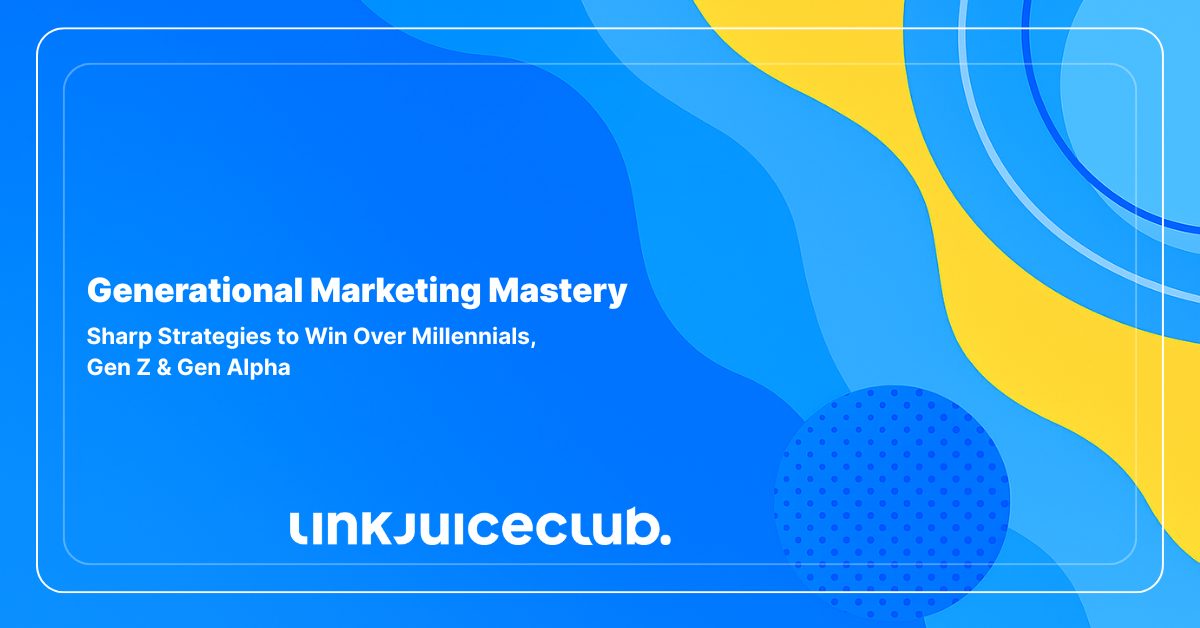
Generational Marketing Mastery: Sharp Strategies to Win Over Millennials, Gen Z & Gen Alpha
They don’t watch cable. They scroll, swipe, and skip ads in under two seconds. If you’re still using yesterday’s tactics to reach today’s buyers, you’re already a few scrolls behind.
Welcome to the era of generational marketing — where personalization trumps persuasion, and your message needs to hit different depending on who’s watching. From the deal-driven Millennials to the hyper-aware Gen Z crowd, all the way to the digital-first Gen Alpha, each group has its own vibe, values, and virtual hangouts.
Want their attention? You’ve got to speak their language, show up where they live online, and stop shouting into the void. Here’s how to do it with precision and personality — not guesswork.
Who’s Who in the Feed? Cracking the Code of Generational Marketing
Before we map out the playbook, you’ve got to know your players.
In the world of generational marketing, every age group has its own rhythm, triggers, and digital turf. Misread the audience, and even the best strategy falls flat. From values to screen time, it’s all about tuning into what actually moves them.

Let’s break it down — generation by generation.
Meet the Millennials: The OG Digital Natives (Born 1981–1996)
They witnessed the rise of the internet, rode through economic waves, and still believe experiences beat ownership. Millennials were the first to double-tap their way through life — but don’t confuse nostalgia with naivety.
🎯 Who Are They?
- Grew up during the internet boom and the 2008 crash
- Prioritize authenticity, value-driven brands, and experience over things
- Digitally fluent — but not easily fooled
📊 What the Data Says:
- 84% trust user-generated content more than polished ads
- Seek well-researched, transparent brands that mirror their values
📱 Where They Hang Out:
- Still loyal to Facebook and Instagram
- Hit up YouTube for reviews and how-tos
- Actually read emails — if there’s real value inside
💡 How to Win Them Over:
- Highlight real people, real stories (think: testimonials & case studies)
- Build loyalty programs that reward trust, not just transactions
- Serve up detailed content that answers questions before they ask
Say Hello to Gen Z: The Scroll-Stopping Realists (Born 1997–2012)
They didn’t adapt to digital — they were born into it. Gen Z talks in memes, thinks in trends, and moves fast. But don’t mistake speed for superficiality — they go deep when it counts.
🎯 Who Are They?
- Grew up with smartphones, social media, and 24/7 global news
- Value individuality, transparency, and social responsibility
- Savvy, skeptical, and impossible to fool with fluff
📊 What the Data Says:
- 73% want brands to help them express their true identity (McKinsey)
- Prefer raw, relatable content over polished perfection
📱 Where They Hang Out:
- Live on TikTok, YouTube Shorts, and Instagram Reels
- Build communities on Discord and Twitch
- Skip ads — but binge content they actually care about
💡 How to Win Them Over:
- Create short-form videos that inform, entertain, or inspire — fast
- Partner with micro-influencers who speak their language
- Show your values, not just your product — and mean it
Gen Alpha: The Touchscreen Natives and Voice-Activated Voters (Born 2010–2024)
They learned to swipe before they could spell. Gen Alpha isn’t just tech-savvy — they’re tech-native. Raised on AI, smart speakers, and gamified everything, their world is fast, filtered, and fully interactive.
🎯 Who Are They?
- Born into homes with voice assistants, streaming content, and on-demand everything
- Influenced by Millennial parents, kidfluencers, and algorithm-approved content
- Expect brands to be fun, fast, and frictionless
📊 What the Data Says:
- Highly responsive to peer-led content
- Engage deeply with gamified, interactive digital experiences
📱 Where They Hang Out:
- Rule the realms of YouTube Kids, Roblox, and Minecraft
- Parents are reached via Instagram and TikTok — often through family creators
- Respond well to brand-safe, visually rich environments
💡 How to Win Them Over:
- Craft parent-approved content that feels like play
- Prioritize digital safety and privacy-first experiences
- Explore interactive storytelling, branded games, or AR try-ons that feel magical
4 High-Impact Strategies to Elevate Your Generational Marketing Game
It’s no longer enough to just reach younger audiences — you need to resonate across generations. Whether they’re scrolling TikTok, building worlds in Roblox, or scanning their inbox for value-packed content, modern consumers expect more than marketing — they expect meaning.
That’s the pulse of effective generational marketing: understanding what each group values, how they engage, and where they spend their time.

These four proven strategies are built for that mission — rooted in data, driven by behavior, and designed to deliver lasting impact.
Strategy 1: Don’t Sell — Solve. Lead With Value or Get Scrolled Past.
Forget splashy ads and feature dumps — if it doesn’t help, entertain, or inspire in under 5 seconds, it’s background noise.
📌 Here’s How That Looks by Generation:
- Millennials
Serve up how-to content that tackles life-stage decisions.
✨ Example: A real estate brand offering a “Renting vs. Buying” calculator that personalizes cost comparisons based on zip code. - Gen Z
Want the real story, fast — with receipts.
✨ Example: A sustainable fashion label posts unfiltered before-and-after clips of thrift flips, using trending audio and honest captions about pricing and sourcing. - Gen Alpha (via parents)
Content must be interactive, educational, and parent-approved.
✨ Example: A STEM toy brand launches an Instagram Live series where families build mini science projects together, turning screens into shared moments.
🚀 SEO Power Move:
Use tools like AlsoAsked or Semrush’s Keyword Magic Tool to uncover high-intent queries. Then build content that directly answers those pain points.
- Target Millennial terms: “how to consolidate student loans”
- Gen Z targets: “best phone for vlogging under $300”
- Gen Alpha (indirect): “screen-free learning games for kids”
Strategy 3: Be the Fix — Show Exactly What You Solve (Fast)
Younger consumers don’t just want to know what you do — they want to know why it matters to them, right now. If your product doesn’t clearly address a pain point, it won’t even register.
Generational marketing thrives on clarity. Cut the fluff and showcase your solution front and center.
⚙️ How to Make It Click:
- Start With the Problem
People don’t buy products — they buy outcomes.
✨ Example: A sleep-tracking app launches a 45-second video showing someone stuck in groggy morning mode → using the app → hitting their sleep goals and waking up refreshed. No narrator, just visual storytelling and stats. - Turn Reviews Into Trust Signals
Let your customers be the proof.
✨ Example: A meal kit service features a live feed of recent customer reviews on its homepage, filtered by “diet type” — so visitors can instantly find someone just like them. - Keep It Mobile, Quick, and Problem-Focused
60 seconds or less. Real people. Real solutions.
✨ Example: A skincare brand uses TikTok to run “Real Skin in Real Life” stories where Gen Z users talk about their skin issues, show their daily routine using the brand, and track visible results over a week.
🔍 SEO That Solves:
Stop guessing — start answering. Use keyword tools to dig into problem-based queries:
| Generation | Sample Keywords |
| Millennials | “budget-friendly fitness plan,” “how to save for first home” |
| Gen Z | “skincare routine for oily skin,” “study tips for college burnout” |
| Gen Alpha (via parents) | “games that teach math,” “calm bedtime routine for kids” |
Embed these in product descriptions, FAQ pages, and blog content to capture both interest and intent.
Strategy 4: Stand for Something — And Actually Show Up
Younger generations don’t just buy products — they buy into principles. Especially Gen Z, who’s known for calling out brands that talk big but act small. If your company claims to care about something, you better back it up with receipts.
In generational marketing, purpose isn’t optional — it’s the ticket to long-term loyalty.
🌍 Walk the Walk — Here’s How:
- Align With a Cause That Actually Fits
Don’t jump on the latest issue just to trend. Find a purpose rooted in your business DNA.
✨ Example: A sustainable packaging startup partners with beach cleanup crews and uses their own packaging waste in promotional upcycling videos. - Show, Don’t Signal
Talking is cheap — showing is everything.
✨ Example: A coffee brand launches a live dashboard showing how many gallons of water their eco-farm initiative has saved this month. Customers get updates via SMS after every purchase. - Involve Your Community
Let your audience be part of the impact.
✨ Example: An apparel brand offers a discount for every used item returned for recycling and features customer-submitted videos of the items being reused.
🧠 Long-Term Brand Equity Move:
Build a “Values” page on your site — not a wall of text, but a scrollable timeline or interactive visual.
Highlight real-world actions, partnerships, and goals achieved.
📈 Stat Check: A 2023 Sprout Social report found 55% of consumers (and a larger share of Gen Z) expect brands to take a clear stand on social issues — but more importantly, to prove it through action.
Final Word: Aligning Generational Marketing With Long-Term SEO Wins
If you’re aiming to grow in today’s digital landscape, you’re not just marketing to generations — you’re building for algorithms and audiences alike.
The new wave of consumers isn’t just younger — they’re sharper, more selective, and more search-savvy. That means every move you make, from social content to site structure, needs to serve both your users and your SEO goals.
Lock in These Core Alignments:
- Authenticity = Trust = Clicks.
When your content is real, relatable, and rooted in value, you earn backlinks, shares, and engagement that Google loves. - Mobile-First Isn’t a Trend — It’s a Standard.
Mobile performance directly impacts rankings. Prioritize load speed, layout, and UX — or risk losing Gen Z before your page even loads. - User Intent Is Your North Star.
From Gen Alpha parents searching “educational games for 5-year-olds” to Millennials looking up “freelancer tax tools,” your keyword strategy must be built on actual, intent-rich queries. - Content That Connects Is Content That Ranks.
When you align storytelling with SEO — think: interactive visuals, UGC-driven product pages, helpful blog posts — you build topical authority and a loyal audience.
Whether you’re running a brand, building an agency, or scaling through white label SEO, the formula is simple: understand your audience by generation, speak their language, and structure your content so both users and search engines say yes.
That’s how you win today — and stay relevant tomorrow.





